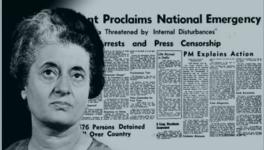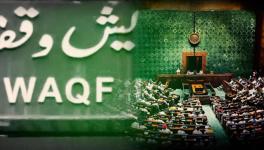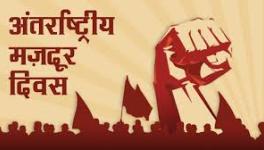Delhi: Law and Disorder Stifling Dissent in Jamia Millia

Following two university-wide memoranda prohibiting protests and slogans on campus, Jamia Milia Islamia, one of the country’s most prominent minority institutions, which played a crucial role in mobilising agitations against the Citizenship Amendment Act in 2020, has become, yet again, a hotbed of State repression. Amidst students being detained and served with show-cause notices, groups have called for a university-wide boycott of classes.
As tensions flare up, police patrol has rapidly increased, strict identification checks have been put in place, and altercations have left students navigating an atmosphere of uncertainty.
For many, memories of the forceful entry of and brutal crackdown by Delhi police on the campus following a confrontation with student protestors in December 2019, remain raw.
Legally curbing expressions of protest
For many, memories of the forceful entry of and brutal crackdown by Delhi police on the campus following a confrontation with student protestors in December 2019, remain raw. In August 2022, a university-wide memorandum was issued, noting that some students with “political agendas” were holding “protests, dharnas and boycott campaigns on the campus for their malafide and political interests” disturbing the “peaceful academic environment” of the university. More than two years later, in November 2024, a second memorandum was released, allegedly in response to student protests against Prime Minister Narendra Modi, which prohibited protests and slogans on campus without the administration's permission. It noted that students had also protested against “other law enforcement agencies of the country on the issues which are not related to the academia as well as to the University.”
These office memoranda, by threatening hefty penalties such as expulsion, fines, and rustication have created an atmosphere of suppression where students risk serious consequences for dissent. Wrapped in the clothing of disciplinary measures, their implications on free speech and political engagements on campus are grave.
Soon after, on December 20, 2024, Jamia’s ‘Property Department’, warned against the defacement of property including writing, painting, and putting up posters without permission. While the Property Department’s mandate, on the face of it, is to upkeep campus infrastructure, it routinely fines and threatens legal action against students for “property defacement”, which includes putting up posters, graffiti or even paintings.
In its December 20 notice, the Department warned of a fine of up to Rs 20,000 for “defacing” university property, and warned of forwarding students’ names to the police for prosecution under state and central laws. It also informed, in a matter of fact way, of the decision to install more CCTV cameras around the 239 acre campus.
The notice brazenly threatens students of prosecution under the Delhi Prevention of Property Defacement Act, 2007, a law which has been routinely invoked by the Delhi police to charge and harass student protestors.
“The notice is emblematic of a broader tendency within institutions to frame dissent as something inherently disruptive rather than a form of engagement or dialogue.”, said Shah Kulsum Shaikh, a former Jamia student who led the graffiti scene during the 2019 CAA-NRC protests in the university.
The notice brazenly threatens students of prosecution under the Delhi Prevention of Property Defacement Act, 2007, a law which has been routinely invoked by the Delhi police to charge and harass student protestors. Section 3 of the Act provides for a fine of upto Rs 50,000 or a year of imprisonment for putting up posters or painting on walls. Just between 2020 and 2022, the police registered a whopping 1468 cases under the 2007 Act, and arrested 929 protestors.
The department also threatened to charge students under Section 324 of the Bharatiya Nyaya Sanhita, 2023. The provision allows imprisonment for upto five years alongwith fine for ‘mischief’. Of even more concern is that it is a cognizable charge - the police could arrest and start investigating without a judge’s permission.
The protests began on February 10, 2025, with students condemning the administrative repressions which included the issuance of the memoranda and the circulation of show cause notices against two PhD students of the varsity’s Hindi department, for allegedly organizing a demonstration last year commemorating the 2019 police violence in the campus. Tensions escalated in the early hours of February 13 when Delhi police detained more than 10 students from the protest site. By the time they released them the next day, the fear of shrinking campus security had already settled in.
Identification checks, police presence and flaring tensions
Since the beginning of the protests in February 2025, the university campus has witnessed increased police deployment with security personnel standing at the campus gates in large numbers. A rapid action force vehicle is stationed at the campus frequently. For students, it is an intimidating, everyday site . “Our University is our second home and their presence feels like an intrusion into my personal space,” said Archana Aggarwal, a student of the AJK Mass Communication Research Centre at Jamia Millia Islamia, “It does not make me feel safe at all.”
Archana generally commuted to the university through motorbike riding apps such as Uber and Ola. “Usually they allow the bike rider to drop me inside the campus. But since February 11, they have not been allowing that. They are also very strict about our ID card.”
“I have been a Jamia student since high school and never before have I encountered such stringent measures”, said a student, preferring to remain anonymous. “In case of a missing ID card, many students were asked to go back to their house to get it, despite having a copy of the same on their cellphones. This leads to disruption in our classes.”, the student added.
Frequent altercations have broken out between the students and the guards over these measures. The conflict escalated on February 11, 2025, when a physical brawl ensued between two guards and a student. According to some people who witnessed the incident, this happened after the student failed to show his identity card. Following this, several students blocked that gate and began protesting against the manhandling by the guard.
Disruptions on campus
Soon after the protests at the gate, a scuffle ensued between two groups of students. The police were quickly deployed on the scene, but accounts suggest they did little to pacify the conflict. According to The Jamia Review, an independent media organization at the university, “the police did not enter the campus and curb the situation.” A student of the varsity and an eyewitness to the account, Kashif (name changed) told the university-based outlet, “After the altercation between guards and students, a group of individuals arrived, demanding protestors to clear the campus. But what authority do they have? Many of them have campus bans for past misconduct yet enter freely without ID checks, unlike us. It seems the administration sent them to break up the protest.”
People I spoke to suggested that the disrupting students belong to informal blocs with a history of inciting hostilities on campus. Their precise association with administrative authorities remains unclear, yet the latter’s demonstrated indifference towards the disruptors was telling.
A few hours after this clash, the same group created a campus-wide ruckus. “With the gates of the campus closed, we were trapped inside, running all around in a state of panic and confusion.” Archana recalled. Imtiyaz, a student from the human resource management department recalled that the ruckus went on for thirty to forty minutes. “It exposed significant loopholes in how administrative authority was functioning,” he said. Some students alleged that the disturbance appeared as a deliberate move to undermine the larger protest environment.
“The timing and nature of this ruckus makes it clear, it was orchestrated to distract, divide, and delegitimize our struggle,” a student activist alleged, “The real culprits are those in power who manufacture these divisions to weaken the struggle.”
A rapid action force vehicle is stationed at the campus frequently.
Unlike other central universities in Delhi, Jamia has survived without a student union since 2006. Formal accountability is difficult to pursue. “The administration's refusal to allow [a student union] creates an authority gap, letting these factions run without accountability and threatening campus security,” a student protester, associated with the left-wing Student’s Federation of India (‘SFI’) said.
In an affront to privacy, student protestor’s personal details displayed
In the early hours of February 13, around 14 students - nine women and five men - were reportedly detained from the protest site. A video circulated from that day, shows them being hustled into police buses. As major protests erupted, they were released within the day.
However, on February 14, the administration, reportedly, publicly displayed a list of seventeen students who were alleged of organising a sit-in protest on February 10. This list detailed their names, emails, phone numbers, political affiliations, and photographs.
“I have been getting calls and messages since the morning. While many of them were to inform me about the list, some of them were random messages from unknown numbers.” said Sonakshi, one of the protesters whose details were displayed. She added that some individuals on the list were neither active participants in the protests, nor had any political affiliations. “This is a complete breach of privacy and leaves us vulnerable and exposed to attacks. We can even be lynched”, she said.
The Internet Freedom Foundation condemned this act calling it a “blatant violation of privacy”. The group noted that the actions not only “infringed upon the fundamental rights of these students”, but also created “a chilling effect on free speech and peaceful assembly.”
As journalists huddled outside the university’s gates, the list was surreptitiously taken down.
On February 15, the administration denied displaying the student’s details, blaming “anti-social elements” for the “name-and-shame” act. It also informed that a committee had been constituted to investigate the matter.
The police were quickly deployed on the scene, but accounts suggest they did little to pacify the conflict.
Students suspended, threatened with criminal charges
On February 12, like many others on the list, Sonakshi had faced suspension letters from the chief proctor’s office for “breach of disciplines”. The detailed suspension order noted that Sonakshi and other students violated Jamia’s “rules and regulations”, which included provisions under an ‘Ordinance 14’ - which prohibits the “disobeying the instructions of teachers”, “causing damage, spoiling or disfiguring to the property/equipment of the university”, and any conduct “considered unbecoming of a student.” Ordinance 14 prescribes students to be punished with fine, campus ban, expulsion and rustication.
“I had been regularly attending my classes in the morning and it was only after the classes that I participated in the sit-in protest. How can we disrupt classes if we, ourselves have been attending them?”, Sonakshi added, “Despite several requests for a meeting, the proctor has refused to engage with us.”
The suspension order also suggested that the student’s conduct was in violation of Sections 324, 189 and 356 of the BNS. Section 189 entails the punishment for "unlawful assembly”, putting students under the threat of imprisonment for upto six months with fine, while the last provision refers to defamatory actions.
It also, rather expectedly, threatens to charge the students under the 2007 property defacement law, just as the office memoranda had warned. The order does not detail how these charges were substantiated and how they were specifically linked to the student protesters. The grounds of prosecution are broad and unverified.
The timing and nature of this ruckus makes it clear, it was orchestrated to distract, divide, and delegitimize our struggle
The call to boycott classes reaches a crescendo
Various departments of the university have released statements of solidarity with the protesting students and called for a boycott of classes. They have demanded the suspension orders and disciplinary actions to be revoked, for the student’s details to not be displayed, and for the “constitutional right to gather peacefully within the university” to be reinstated.
Sant Kumar, a PhD student from Jamia’s English department said, “In the absence of a student union, the responsibility falls upon us to stand with our peers and uphold the truth. They cannot silence everyone through suspensions”. Kumar is resolved that their demands could rebuild an academic space where the right to speech and discussion could thrive.
A press release of the SFI suggested that last Monday, over a hundred students protested in front of the history department seeking a withdrawal of the show-cause notices and suspensions. They also called for a revocation of the office memoranda issued in August 2022, and November 2024 which prohibit protests. The demands were forcefully submitted, and the administration's response is now awaited. On February 19, several students of Jamia, alongside other student groups such as the All Indian Student’s Association and the Jawaharlal Nehru University Student’s Union continued the protest at Jantar Mantar.
When I last spoke to her, Kulsum had become weary of the administration’s swift use of the law to suppress expression. “The balance between freedom and decorum is not about suppressing one for the other. It is about recognizing that the very act of suppression - whether through fines, censorship, or removal of works - undermines the essence of freedom itself,” she explained, “Rather than maintaining decorum at the cost of creative and intellectual expression, the administration should seek a more inclusive, democratic way of allowing these voices to be heard while also respecting the need for shared public spaces.”
Maryam Hassan is a Delhi-based freelance journalist. She writes on human rights and minority issues.
Get the latest reports & analysis with people's perspective on Protests, movements & deep analytical videos, discussions of the current affairs in your Telegram app. Subscribe to NewsClick's Telegram channel & get Real-Time updates on stories, as they get published on our website.
























